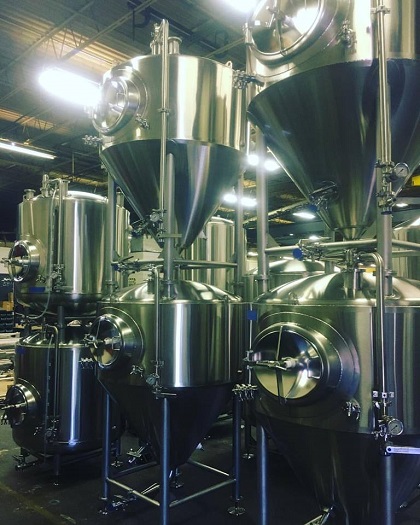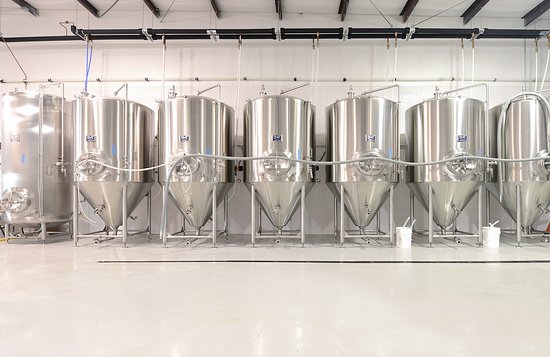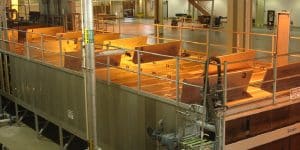
For example, a larger brewery is more likely to be composed of distinct sections such that each is dedicated to a specific phase of the brewing process.
At the other extreme, a microbrewery is more likely to consist of a single room, where the entire brewing process is performed.
Despite the great difference in size, however, much of the brewing process has remained essentially unchanged, as it’s dictated by relatively simple biochemical processes.
A microbrewery, or craft brewery, is typically owned independently and much smaller than the corporate breweries that produce most of the beer appearing in bars and retail shelves.
However, this distinction has become blurred in recent years as major brewers have created some very large “craft breweries.”
Factors Affecting Brewery Equipment Costs
Regardless of their size, all breweries must estimate their brewery equipment costs, which is highly dependent on the volume of beer it needs to produce.
Factors that come into play in estimating the cost of brewery equipment include:
-
- Brewery equipment material
- New or used brewery equipment
- Size of the brewhouse
Brewery Equipment Material
Brewery equipment is made of various materials, the most common brewing kettles being made from copper and stainless steel.
Copper Brewery Equipment
Brewery equipment has traditionally been made of copper, especially the kettles in which the wort is boiled. Copper ore is readily available and easily smelted into pure form.
Furthermore, copper transfers heat quickly and evenly, which is highly desirable for brewing. However, copper reacts with many chemicals, which can give a metallic flavor to the beer. It can also be corroded by many types of cleaning solutions.
Stainless Steel Brewery Equipment
Today’s commercial breweries predominantly use kettles made of stainless steel, although they’re still known as “coppers” regardless of the materials used to make them.
Many modern kettles have copper cladding to provide a more traditional appearance, but this cladding is purely cosmetic as it doesn’t come into contact with the wort. Stainless steel reacts with very few chemicals, although chlorine is one of them.
Brewery equipment made of stainless steel shouldn’t impart any flavors to the beer, provided it isn’t cleaned with bleach. Stainless steel is also much stronger than copper, which is a critical consideration since kettles are pressurized when the wort is boiled.
New or Used Brewery Equipment
In addition to size, the cost of brewery equipment is greatly affected by whether it’s new or used.
Business owners starting a microbrewery often have a limited startup budget that requires them to make some compromises regarding their purchase decisions.
The major equipment that a brewery needs includes the following:
-
- Boilers
- Kettles
- Fermentation Tanks
- Storage Tanks
- Kegs
Filters, cooling equipment, bottlers, refrigerators and cleaning tools are essential equipment for a brewery of any size as well.
Size of the Brewhouse

These components typically include the following:
-
- Mash mixer
- Lauter tun
- Hot liquor tank
- Boil kettle
- Whirlpool
A larger brewery may use a five-vessel brewhouse, in which each of these components is a separate vessel.
A microbrewery is more likely to use a two-vessel brewhouse that combines the mash mixer, lauter tun and hot liquor tank into one vessel, and the boil kettle and whirlpool into another vessel.
The first of these vessels is used to mash the malt and other grains and extract the liquid wort. The second vessel in a two-vessel brewhouse is used to add hops and other ingredients to the wort and boil the resulting mixture. The wort is then allowed to settle, allowing solid particles to be separated from the liquid.
The capacities of brewhouses are typically measured in barrels (bbls), which is 31 U.S. gallons in the United States.
Ss Brewtech manufactures brewhouses in a range of capacities, such as its 3.5 bbl system that retails for just under $50,000. Its 20-bbl brewhouse is slightly under $100,000.
Fermentation Tanks
Fermentation is the next step in the brewing process after the wort has been prepared.
Fermentation tanks hold the wort while yeast converts to sugar in the wort into alcohol and carbon dioxide. These tanks should have a cone-shaped bottom, which facilities the process of recovering the yeast for later use.
Jacketed fermenters allow you to control the mash temperature more easily, but they’re also considerably more expensive.
Stout Tanks and Kettles manufactures fermenters in a range of sizes, primarily for smaller breweries. Its ½ bbl non-jacketed fermenter sells for a little over $400, while its 4 bbl is a little under $2,500. The jacketed fermenters start at over $3,200 for a 1 bb fermenter and go up to nearly $6,000 for a 5 bbl unit. Larger models up to 20 bbl require individual quotes.
Brite Tanks
Beer is filtered and pumped into another tank known as a secondary fermentation or brite tank after the fermentation process is largely complete.
A brite tank allows the beer to further clarify and carbonate before being transferred into a bottle, can or keg for consumption. Some brewpubs also serve beer directly from a brite tank.
The cost of non-jacketed brite tanks from Stout Tanks and Kettles range from about $1,400 for a 1-bbl model to about $4,600 for a 7-bbl model. A 5-bbl jacketed brite tank sells for a little over $5,800, and quotes for other sizes are available upon request.
Kegs
Brewers still need kegs for storing beer, even if they eventually transfer it to bottles or cans. They may also sell or serve beer in kegs to bars and restaurants, or serve it directly from kegs in a brewpub.
A ½ bbl keg is one of the most common sizes, which sells for about $125 from Beverage Factory. A pallet of 27 of these kegs is also available for a slight discount.
Kegs also need to be washed to prevent beer from spoiling or tasting bad. Smaller breweries may be able to get away with washing kegs by hand, but larger ones will prefer the greater efficiency and reduced costs of a keg washer.
Portland Kettle Works offers a three-keg washing system for slightly under $10,000.
Estimating the Cost of Brewery Equipment
From equipment costs to brewhouse size, building expenses and licensing, the cost of running a brewery can range drastically based on your specific operation.
When estimating the price of your investment, it’s important to consider the cost of brewery equipment for your brewing operation. Fortunately, there are various types of equipment in which to choose as well as brewery equipment financing options to help you get off the ground and running.
Request a Brewery Quote





 Contract
Contract Food & Bev
Food & Bev